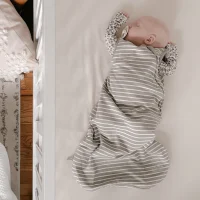Ensuring safe and restful sleep for a newborn is among the highest priorities for new parents. According to the American Academy of Pediatrics (AAP), infants up to six months old should sleep in a safety-certified bassinet, crib, or playyard located in their parents’ bedroom. Among these options, bassinets and co-sleepers—equipped with a drop-down side for easy placement beside an adult bed—are often preferred for their compact, portable design and shallow sleeping area, which simplifies lifting a newborn in and out.
Extensive research into 25 bassinet models, including rigorous testing of 10 during the demanding early months of parenthood, reveals that no single product suits every family. Factors like lifestyle, budget, and personal preferences play pivotal roles in determining the ideal choice. To address diverse needs (and the universal urge for much-needed rest), six exceptional models have been identified as top contenders for balancing functionality and convenience.
Bassinets and Bedside Sleepers: Key Features and Safe Usage
Designed for newborns up to six months old, bassinets offer a secure and accessible sleep space for infants. These compact sleep solutions are notably smaller than standard cribs—typically measuring around 30 inches in length and 18 inches in width—making them ideal for placement near adult beds. Their shallow design (approximately 10 inches deep) simplifies nighttime care, such as feeding or diaper changes, while reducing strain for parents recovering from childbirth.
A subset of bassinets, bedside sleepers (often called “co-sleepers”), feature a drop-down side to position them flush with an adult bed. While the term “co-sleeper” may imply unsafe bed-sharing, these products adhere to safety guidelines by maintaining a separate sleep surface. The American Academy of Pediatrics emphasizes that true bed-sharing increases risks of SIDS and suffocation, making bedside sleepers a safer alternative for close proximity during nighttime care.
Both bassinets and bedside sleepers are suitable until infants reach developmental milestones like rolling over or pushing onto hands and knees—often occurring before six months. Parents should verify weight limits (typically 15–20 pounds) and ensure the sleep surface remains securely attached and level to prevent unsafe positioning. For longer-term use, playards with bassinet inserts or standard cribs placed in the parents’ room may be preferable.
By prioritizing safety certifications, accessibility, and developmental needs, these sleep solutions balance convenience with adherence to pediatric recommendations.
Lightweight and compact: Chicco LullaGo Anywhere LE Portable Bassinet
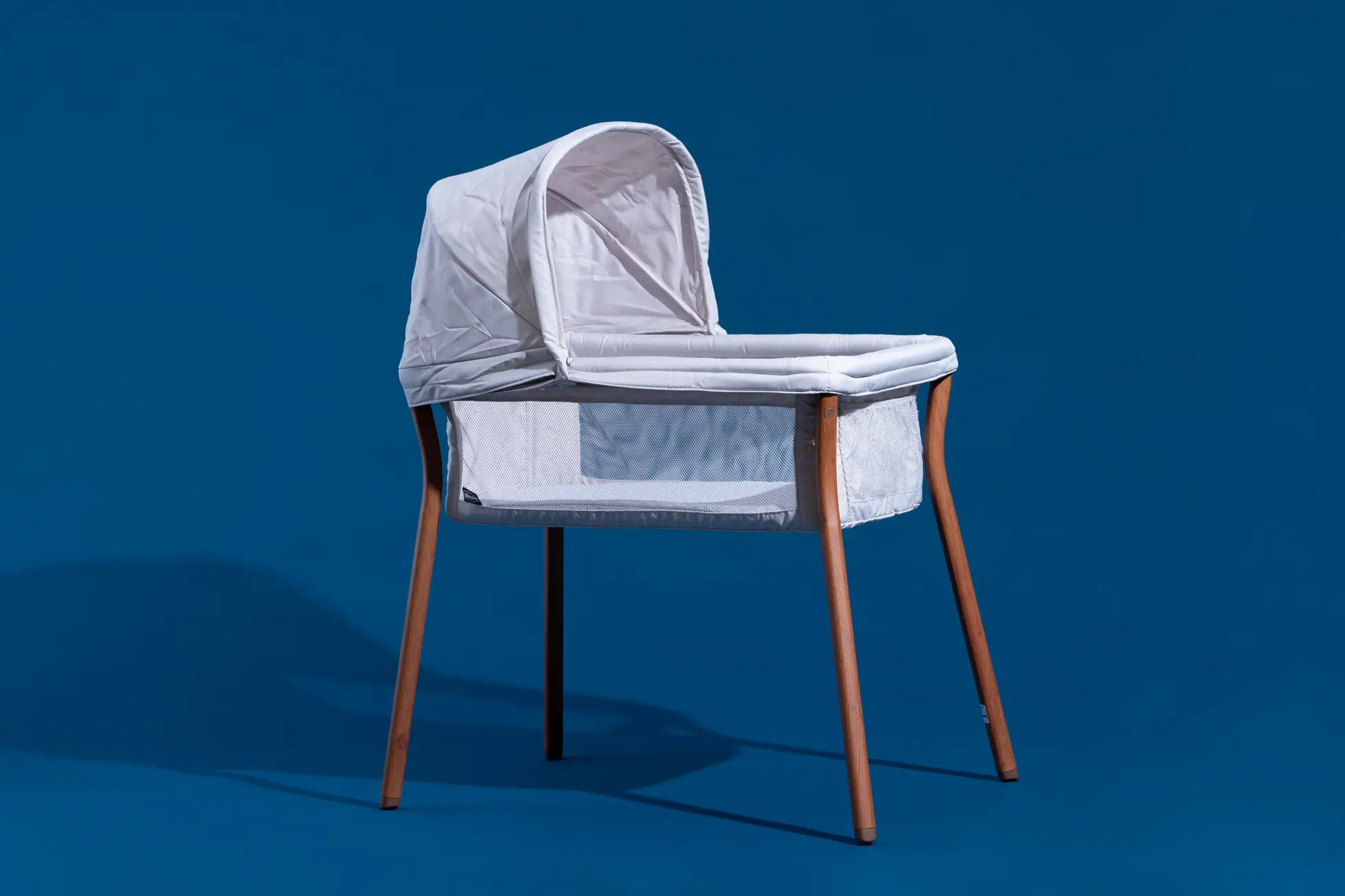
Ideal for families seeking an affordable, no-fuss bassinet that combines style with practical portability. This attractive sleeping solution disassembles effortlessly and stores compactly in its dedicated carrying case, making it particularly suitable for families planning to travel with their infant.
What makes this bassinet stand out is its genuine portability – a feature many competitors claim but few execute well. At just 12.6 pounds (significantly lighter than comparable models), the Chicco LullaGo Anywhere LE assembles in minutes and stows neatly in its included travel bag. Even for homebound use, this model shines through its straightforward functionality. While lacking height adjustments and generous storage, it compensates with user-friendly operation and budget-friendly pricing that undercuts fancier alternatives. Its clean-lined, mid-century inspired design blends seamlessly with contemporary home decor.
The assembly process proves remarkably stress-free for sleep-deprived caregivers. Whether following instructions or working intuitively, most users can unpack and set up the bassinet within five minutes. Four metal legs featuring wood-effect finishes (stylish though slightly artificial-looking) click securely into the bed frame. These legs angle outward to form a reassuringly stable foundation, balancing aesthetics with practical stability.
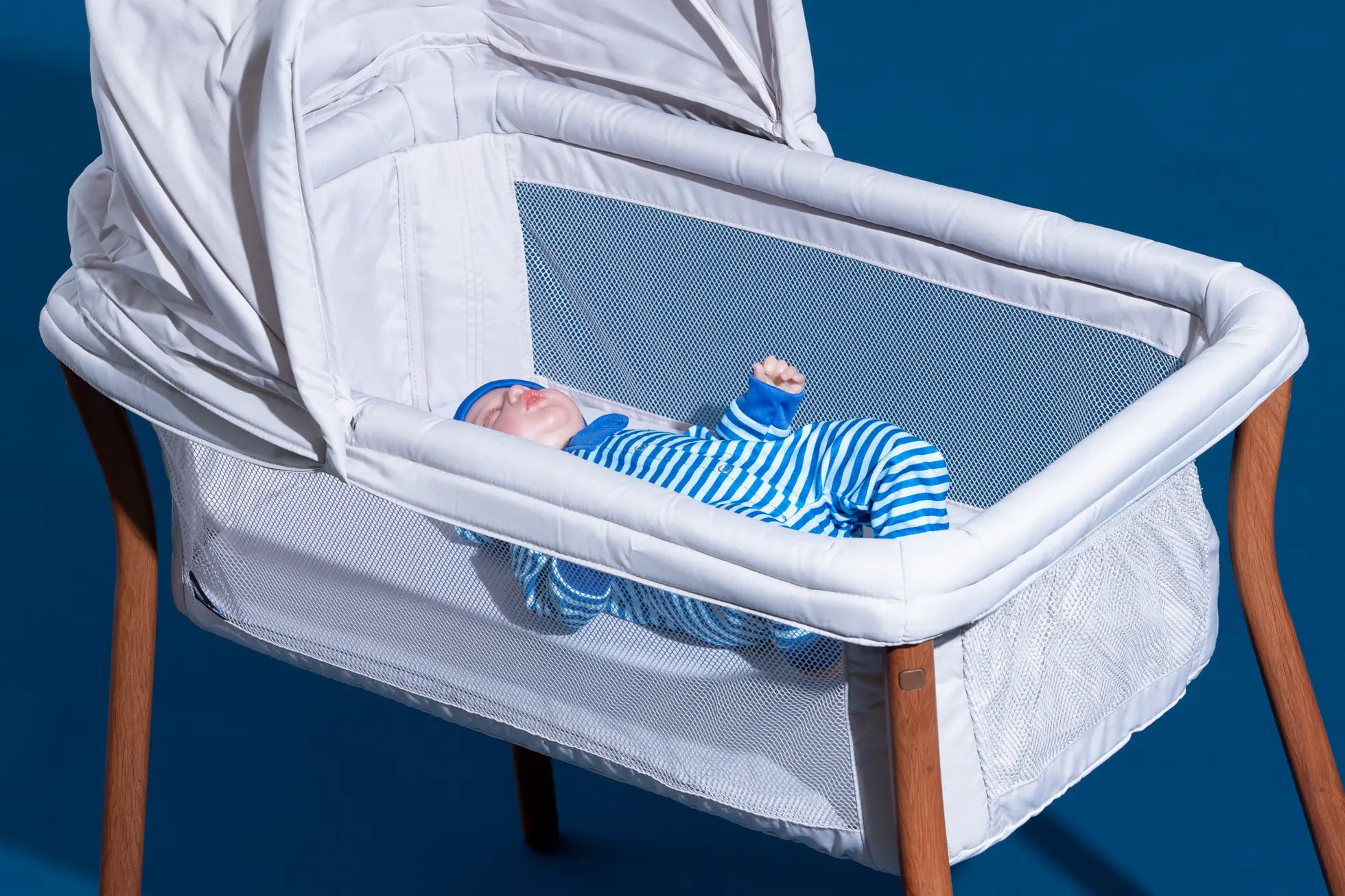
With its space-efficient design, this bassinet fits comfortably in compact bedrooms. The Chicco LullaGo Anywhere LE’s exceptional lightness became particularly valuable during early postpartum days – even while recovering from childbirth, I could effortlessly relocate it between rooms without strain.
The structure combines polyester fabric (available in muted beige or gray tones) with breathable mesh panels, all detachable for machine washing. Transparent mesh walls provide 360-degree visibility, while a fixed canopy at the head end effectively shields infants from harsh lighting during daytime rests. Notably, the product holds Greenguard Gold Certification, ensuring reduced exposure to potentially harmful chemical emissions in its construction materials.
Included accessories feature one custom-fitted sheet, though parents should anticipate purchasing extras due to the mattress’s uncommon dimensions – a typical limitation among specialized bassinets requiring proprietary sizing.
Practical storage solutions include a shallow external pouch at the bassinet’s base, ideal for keeping essentials like diaper creams, travel-sized wipe packs, or emergency diapers within arm’s reach. This thoughtful addition enhances functionality without compromising the unit’s streamlined profile.
Flaws but not dealbreakers
While the bassinet’s compact design enhances portability, its snug proportions may limit long-term usability. Measuring 27 by 15 inches internally—the smallest among tested models—the space felt restrictive for my growing infant as early as 3½ months, despite remaining under the 20-pound weight threshold. This aligns with frequent customer observations noting children outgrowing it around the 4-month mark.
Families prioritizing extended use before crib transitions might consider more spacious alternatives like the Maxi-Cosi Iora Bedside Bassinet. Additionally, the fixed-height legs and minimal storage—just a single shallow pocket—mean limited adaptability. Those desiring adjustable features or organizational extras may find the design too basic for their needs.
Technical Details
Assembling this bassinet requires minimal effort, with setup typically completed in five minutes. The unit measures 30 inches in length, 18 inches in width, and stands 42 inches tall, maintaining a lightweight profile at just 12.6 pounds. Designed for infants up to 20 pounds, it accommodates newborns but lacks adjustable features to adapt to growing needs.
Storage options are limited to a single shallow compartment at the base, suitable for small essentials like diapers or creams. Included components feature a protective canopy, a travel-friendly storage bag, and one fitted sheet—though caregivers may need to purchase additional sheets due to the mattress’s unconventional sizing. The design prioritizes straightforward functionality over advanced features, focusing on portability and ease of use.
Spacious and sturdy: Maxi-Cosi Iora Bedside Bassinet
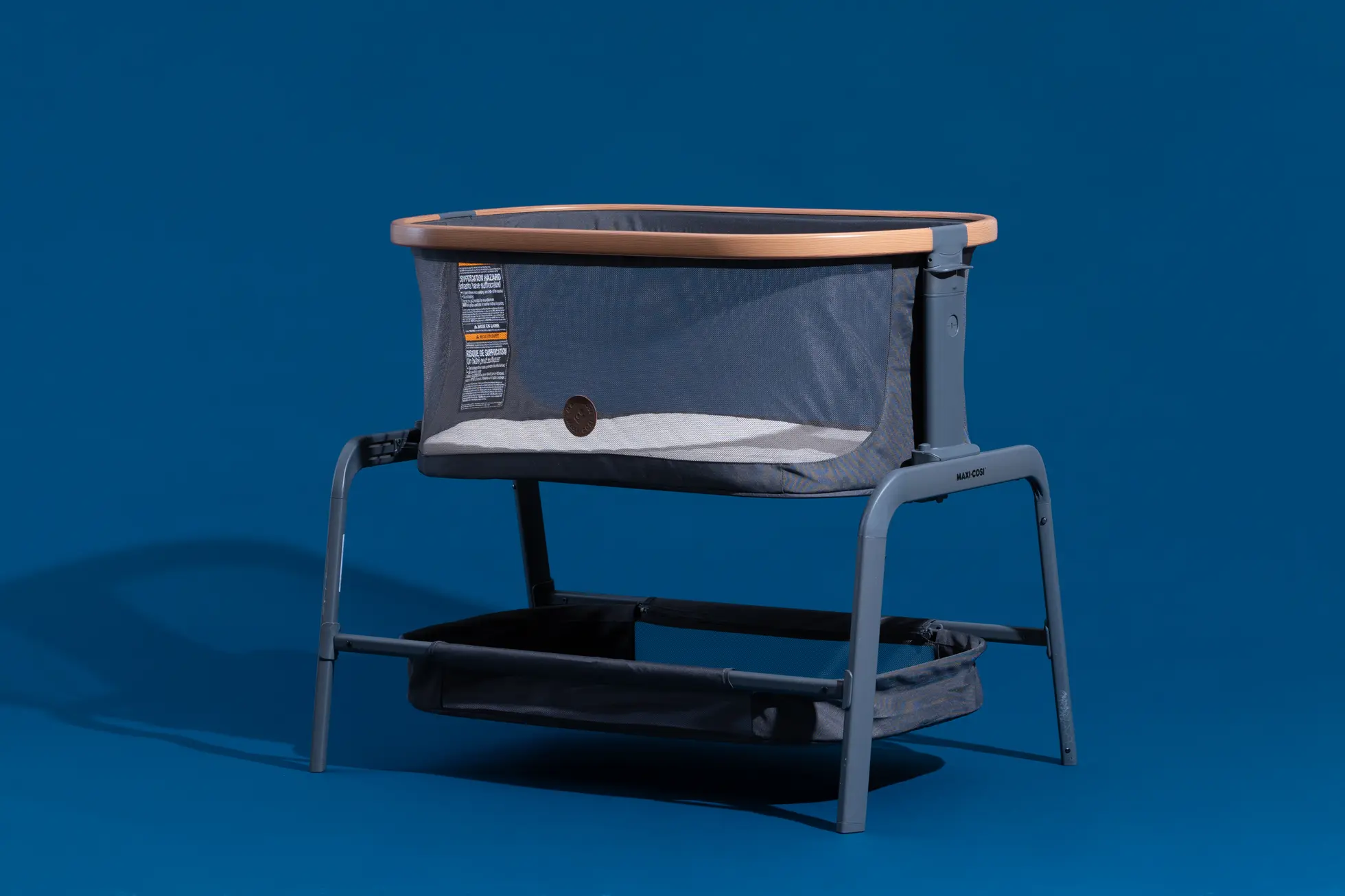
Ideal for: Families seeking a bassinet with a roomier, furniture-inspired design and those who value adaptable features or additional storage.
We adore the Maxi-Cosi Iora Bedside Bassinet for its sleek, contemporary style—a standout among the models we’ve tested. Its generous 20-by-32-inch sleeping space and 25-by-38-inch footprint offer ample room for movement. (Only the Cradlewise, a smart convertible bassinet-crib hybrid, surpassed it in size during our 2022 testing.) My son sprawled comfortably in his sleep sack, shifting positions overnight without feeling cramped, even as he approached four months. The deeper interior, with the mattress positioned roughly 10 inches lower than most bassinets, does require slightly more effort to lift a baby in and out.
Design-wise, the Iora combines a sturdy metal base with a metal top rim featuring a wood-grain finish and breathable mesh sides. Available in four muted tones—light gray, charcoal, sage green, and tan—it blends seamlessly with home decor. The mesh panels provide exceptional visibility, making it easier to check on a resting baby from any angle compared to other bassinets.
Assembly takes roughly 10 minutes, and it disassembles compactly into an included travel bag. However, weighing nearly 27 pounds, it’s significantly heavier and less portable than lightweight options like the Chicco LullaGo Anywhere LE. That heft, though, contributes to its rock-solid stability. It feels like a permanent fixture in a room, staying firmly in place even during nighttime shuffles.

Fitting the Maxi-Cosi Iora into our compact bedroom proved challenging initially, as it partially obstructed the pathway to the bathroom. However, once positioned beside our bed, its height-adjustment mechanism became a standout convenience. By squeezing the handles on either end, we effortlessly raised or lowered the bassinet across its five customizable levels to align perfectly with our mattress.
While the Iora doesn’t extend over the bed like the Halo BassiNest Swivel Sleeper 3.0, its lateral adjustability allows sliding into one of three positions, bringing the bassinet closer to the bedside. The sleep area features a firm, padded mattress that feels notably plush compared to standard options—though Maxi-Cosi advises handwashing it. A machine-washable mattress protector is included, but fitted sheets for the Iora are frustratingly unavailable in the U.S. (they’re sold exclusively on the brand’s UK site). The bassinet’s mesh walls, meanwhile, can be easily cleaned with a damp cloth and mild soap.
Our favorite aspect was the spacious storage basket beneath the bassinet, the largest we’ve encountered in our testing. It comfortably held extra diapers, pajamas, and pacifiers, allowing midnight necessities to stay within arm’s reach—a game-changer for sleep-deprived parents.
Considerations to Note
The Maxi-Cosi Iora, while praised for its spacious design and functional features, may pose challenges in compact rooms due to its larger footprint. Its deeper interior—placing the mattress approximately 10 inches lower than average bassinets—can complicate lifting a baby in and out, particularly for parents recovering from C-sections. Additionally, while it includes a washable mattress protector, the absence of fitted sheets for purchase in certain regions (like the U.S.) and limited spare bedding options may frustrate users seeking convenience.
Technical Details at a Glance
Assembly takes roughly 10 minutes, and the bassinet disassembles into a travel-friendly bag for portability. Measuring 40.55 x 22.44 x 7.28 inches (LWH) and weighing 26.9 pounds, it accommodates infants up to 20 pounds. Adjustments include five vertical height settings and three horizontal positions to align with bedsides. A standout feature is its roomy under-bed storage shelf, ideal for essentials like diapers or blankets.
With a drop-down side: Arm’s Reach Clear-Vue Co-Sleeper Bassinet
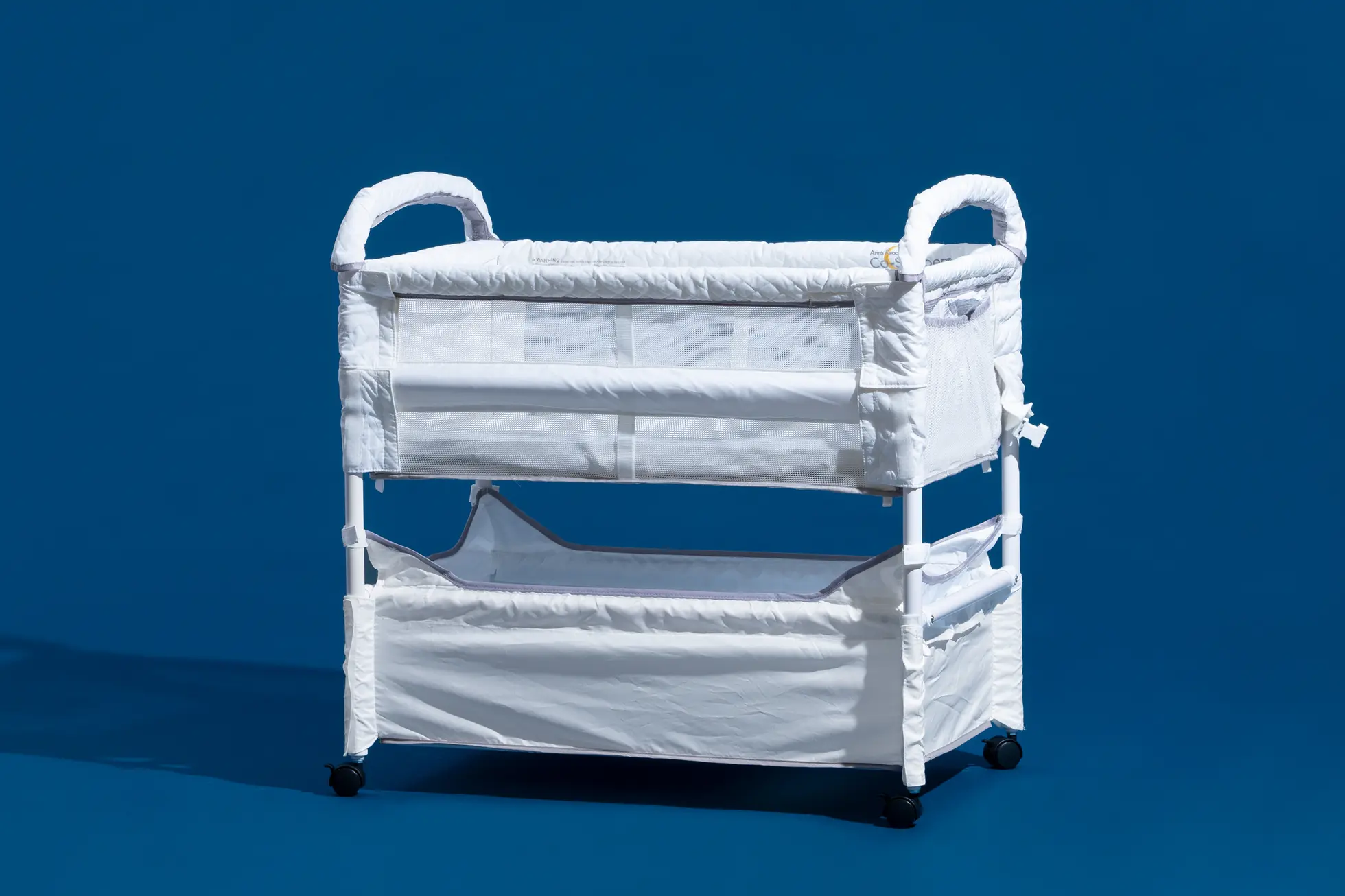
Ideal for: Caregivers prioritizing practicality over aesthetics in a co-sleeper bassinet that securely attaches to adult beds, enabling easy nighttime access and proximity to the baby.
Why it stands out: The Arm’s Reach Clear-Vue Co-Sleeper Bassinet has earned Wirecutter’s consistent recommendation since 2017 for its affordability and functional design. As a parent who relied on it exclusively in 2018 and retested it against newer models in 2022, I found it remains a competitive choice. Its popularity is further validated by reader feedback, where it ranked among the top three preferred models alongside premium options like the Snoo Smart Sleeper and Halo BassiNest.
Designed as a compact, wheeled playpen with four sides, one long side folds down using hook-and-loop fasteners. This feature simplifies safely transferring a baby to an adult bed for nighttime feedings or care, mimicking the convenience of co-sleeping without violating AAP safety guidelines against shared sleep surfaces. A short mesh barrier remains in place to prevent accidental rolling, acting as a protective boundary rather than an open connection between surfaces.
An included strap secures the bassinet to the bed, eliminating gaps that might form overnight. While we appreciated the freedom to move the bassinet during the day and rarely used the strap, its straightforward design adds stability for those prioritizing a fixed setup. The bassinet’s no-frills approach—focusing on durability and ease of use—makes it a practical, budget-friendly option for sleep-deprived families.
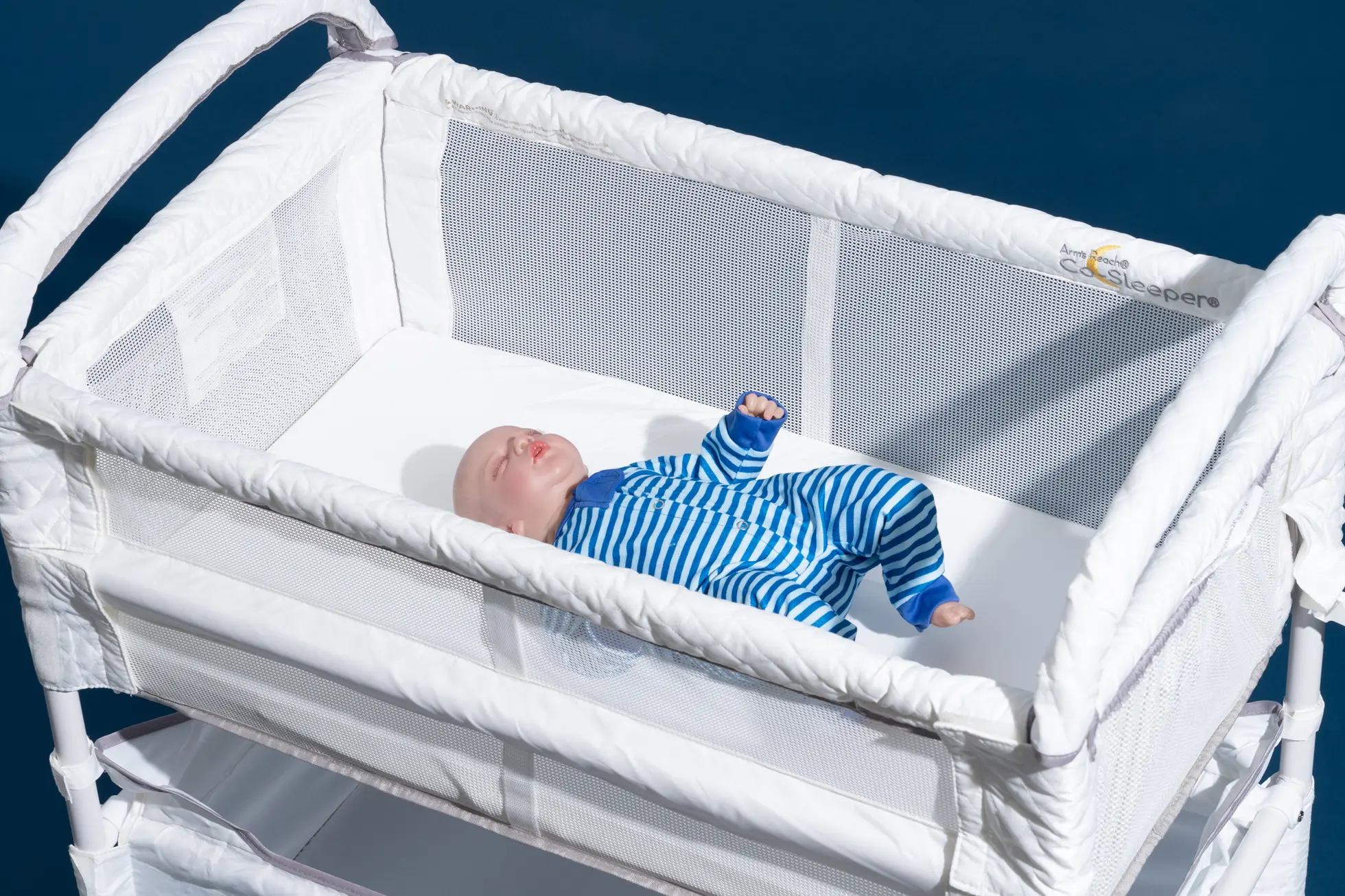
The Arm’s Reach Clear-Vue Co-Sleeper combines practicality with a roomy design, featuring transparent mesh walls and a spacious 34-by-20-inch sleeping area that surpasses many bassinets we’ve tested. My oldest child comfortably used it until nearly five months old, when her height—though still well under the 18-pound weight limit—began to outgrow the space.
Adjusting the bassinet’s height to match adult beds (24 to 30 inches tall) involves manually raising or lowering each leg in 2-inch increments. While this process demands a bit of hand strength and patience, it ensures compatibility with most bed heights. The included water-resistant mattress and machine-washable fitted sheet simplify upkeep, and the mesh walls can be spot-cleaned with mild detergent.
Storage is a major perk here. A sizable lower compartment and smaller pockets at the head and foot keep essentials like clothes and diapers organized and within reach, minimizing nighttime disruptions. Only the Maxi-Cosi Iora offers more storage among our picks. Four lockable wheels make repositioning effortless, adding to its versatility in small spaces.
Sturdy and stable, this bassinet delivers reliable functionality at a reasonable price. While it lacks some modern frills, its durability and thoughtful design make it a solid investment for caregivers prioritizing practicality.
Drawbacks to Consider
Assembling the Arm’s Reach Clear-Vue Co-Sleeper can be time-consuming—taking around 24 minutes—due to its numerous small components, including screws that require temporary removal and reinsertion. While manageable for one person, having an extra set of hands simplifies the process significantly.
The co-sleeping functionality may struggle with platform or low-profile beds, as the bassinet’s minimum height setting is 24 inches. Aesthetically, its utilitarian design leans toward a clinical appearance compared to sleeker competitors, and the mesh’s crinkly nylon fabric lacks a premium feel.
Technical Specifications
- Assembly time: 24 minutes
- Dimensions: 34” L x 20” W x 34.5” H
- Weight: 26 pounds
- Weight limit: 18 pounds
- Adjustability: Vertical height settings (compatible with beds 24–30 inches tall)
- Storage: Undershelf basket and foot-end pocket
- Included accessories: Fitted sheet, bed attachment strap/plate set
- Features: Drop-down side, lockable wheels
While functional and sturdy, its design prioritizes practicality over style, making it a no-nonsense choice for caregivers valuing utility over aesthetics.
Swiveling and detachable: Halo BassiNest Swivel Sleeper 3.0
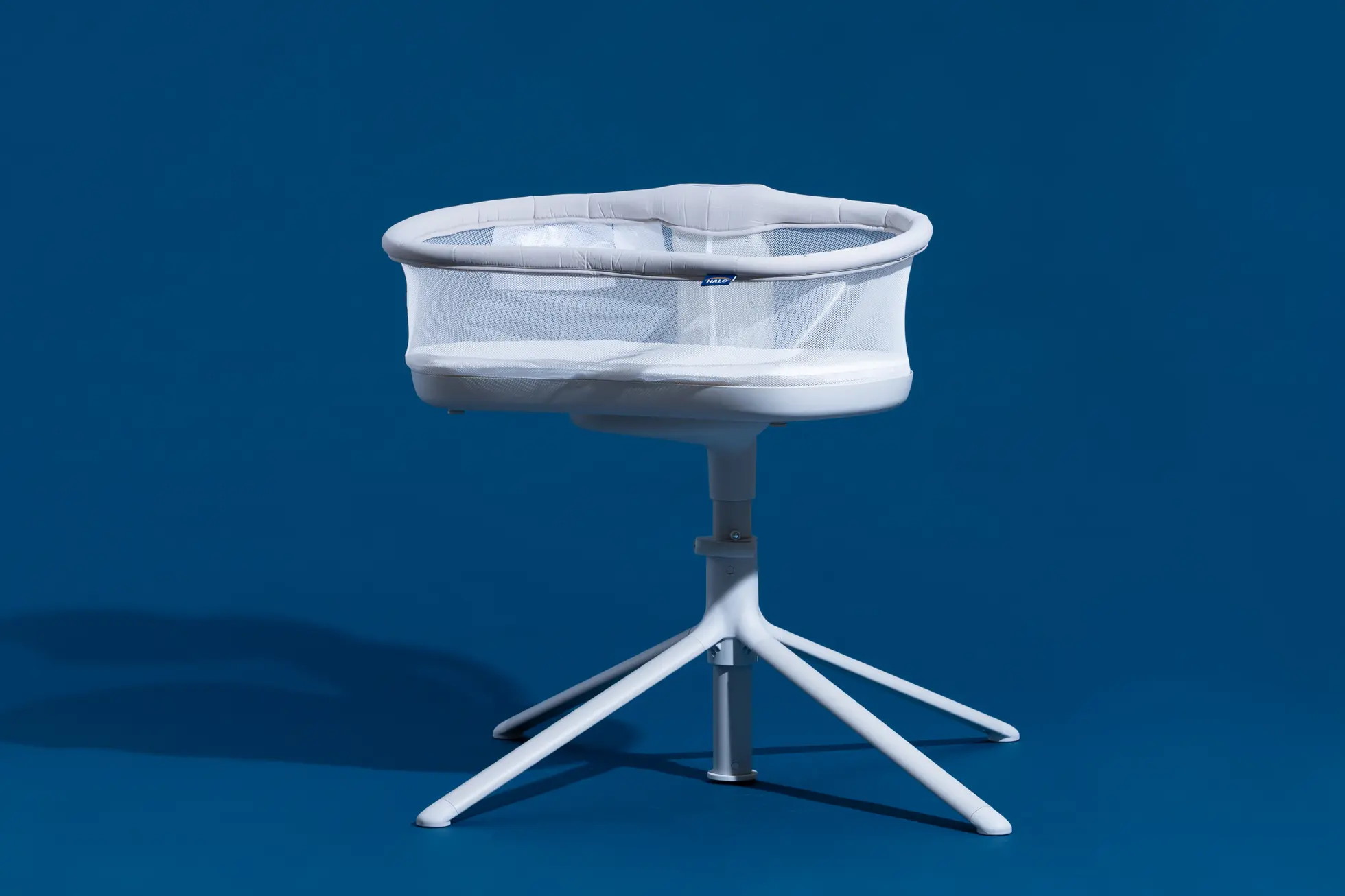
Ideal for: Parents seeking the convenience of a bedside bassinet without permanent attachment to its base. The Halo BassiNest Swivel Sleeper 3.0 bridges the gap between traditional co-sleepers and standalone bassinets, offering easy access to your baby while maintaining flexibility.
What makes it stand out: Unlike conventional co-sleepers with fixed drop-down sides, this model features a collapsible mesh wall that retracts temporarily for quick access. A gentle press lowers the side, allowing effortless lifting of your baby for nighttime feedings—ideal for postpartum recovery or parents preferring minimal disruption. The wall automatically springs back into place, but can also be locked upright for added stability.
The bassinet’s 360-degree swivel function lets you rotate the sleep area over your bed, creating a hovering sleep space when paired with compatible bed heights (24–30 inches). Adjusting its height between 36 and 44.5 inches is simplified via a central lever, accommodating various bed setups. For optimal positioning, the base legs can be partially tucked under beds with frames at least 4.5 inches off the floor.
Assembly requires only a screwdriver, and the 23 x 32.25-inch sleep area—equipped with a firm, waterproof mattress and machine-washable fitted sheet—accommodates infants up to 20 pounds. Transparent mesh walls ensure visibility and airflow, while spot-cleaning with mild detergent or removable machine-washing simplifies maintenance. Though compact compared to bulkier models, its balance of portability and functionality makes it a practical choice for modern nurseries.
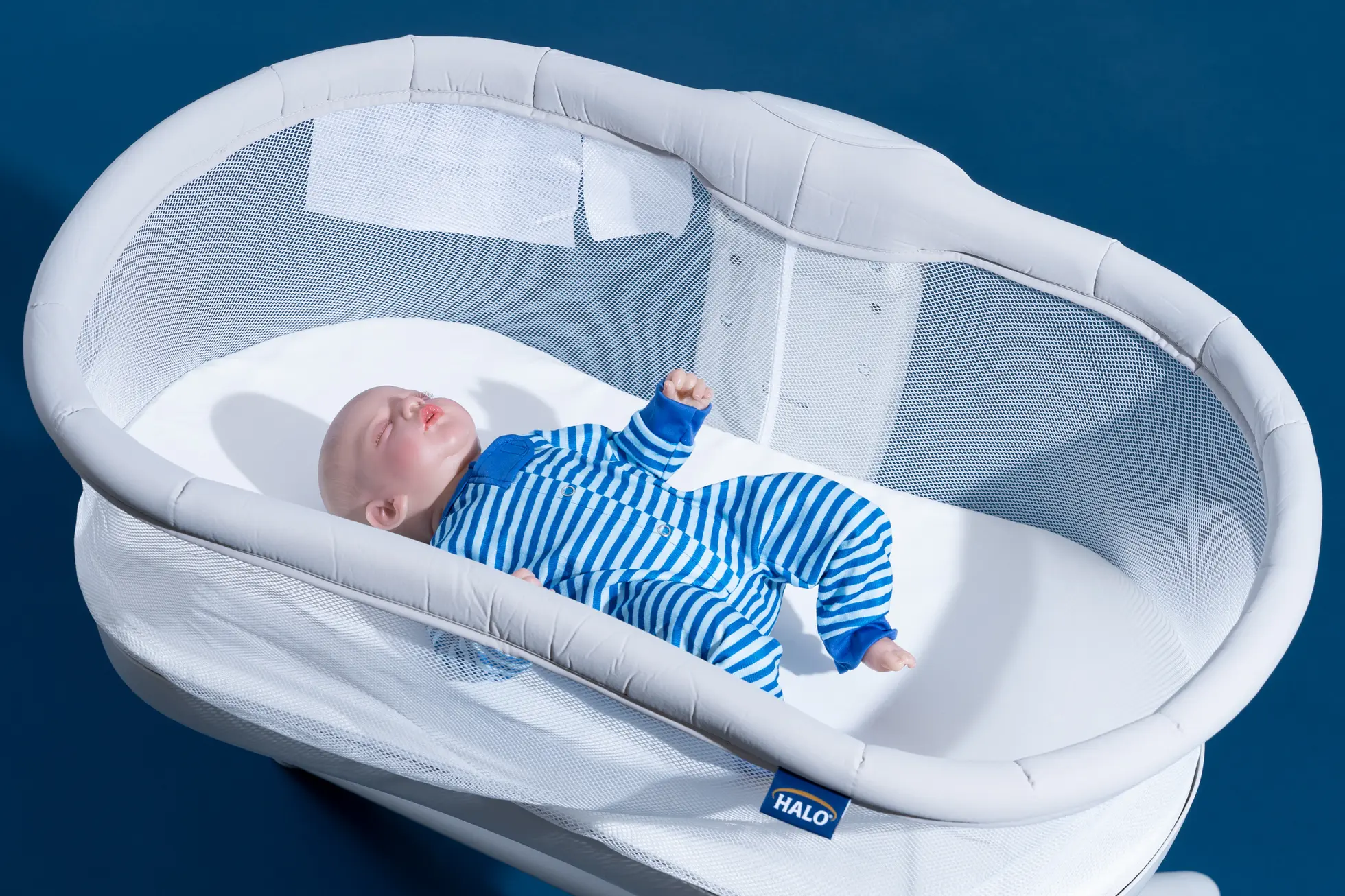
The Halo BassiNest 3.0 stands out for its versatile design—the detachable sleep unit separates from its base, functioning independently as a portable sleep space. A simple lever release allows the 9-pound upper section to transform into a lightweight travel crib or floor-level nap station, a unique feature among comparable models.
I found this detachable design invaluable for multitasking. Whether showering or preparing meals, I could keep my baby safely nearby. Its portability also proved practical during visits to family homes, such as accommodating midday naps at a relative’s house during holiday gatherings.
The removable nest’s adaptability bridges the gap between stationary bedside sleepers and mobile solutions, offering caregivers flexibility without compromising safety. Its lightweight build and compact form simplify transitions between rooms or locations, making it ideal for households prioritizing convenience.
Points to Consider
The Halo BassiNest 3.0 lacks built-in storage—a feature we appreciated in other models—which limits its convenience for stashing essentials like diapers or pacifiers. Its sizable 34 x 34-inch footprint may also overwhelm tight spaces. While the redesigned base addresses stability issues seen in older versions (such as tripping hazards from horizontal legs), the downward-splaying legs can complicate positioning under low-profile beds, reducing the bassinet’s ability to snugly align with mattresses.
Technical Details
Assembly time: 12 minutes
Dimensions: 33” L x 32” W x 45” H
Bassinet weight: 22.6 pounds
Weight limit: 20 pounds
Adjustability: Vertical height and 360-degree swivel
Storage: None
Included accessories: Fitted sheet
Key feature: Detachable sleep nest
Though practical and innovative, the BassiNest 3.0’s compromises highlight its focus on mobility and safety over storage or compact design.
Intuitive and responsive rocker: Snoo Smart Sleeper
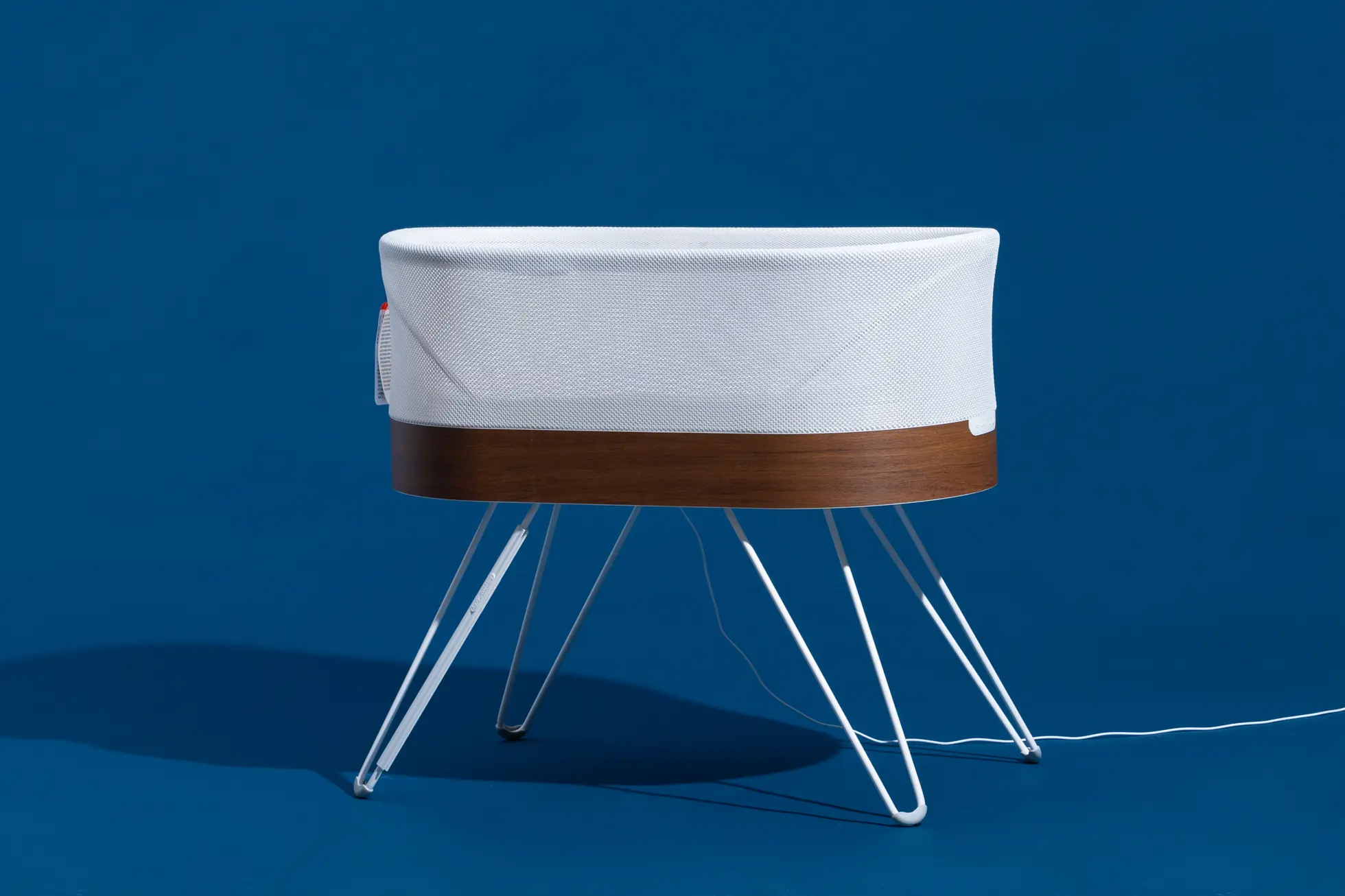
The Snoo Smart Sleeper appeals to caregivers willing to invest in high-end solutions for maximizing newborn sleep during challenging early months. This technologically advanced bassinet claims to extend nightly rest by 1-2 hours through automated soothing—a bold promise backed by its sensor-driven design.
Equipped with microphones and motion detectors, it analyzes a baby’s cries and movements to activate gentle rocking paired with white noise, mimicking parental comforting techniques. The rhythmic motion and shushing sounds aim to lull infants back to sleep without requiring physical intervention, potentially easing exhaustion for sleep-deprived families.
Real-world experiences vary widely. While some parents report transformative results—including our own trial where it effectively reduced nighttime disruptions—others find its performance inconsistent. Critics note that not all babies respond to its automated system, leaving some families questioning the value of its premium price tag.
Technical refinements like Wi-Fi connectivity, customizable LED lighting via light sensors, and a springless motor designed for silent operation underscore its engineering focus. Yet the lack of universal success highlights a key caveat: sleep solutions remain deeply personal, influenced by individual infant temperaments. For those willing to gamble on its potential benefits, the Snoo offers a blend of innovation and luxury—but with no guaranteed outcomes.
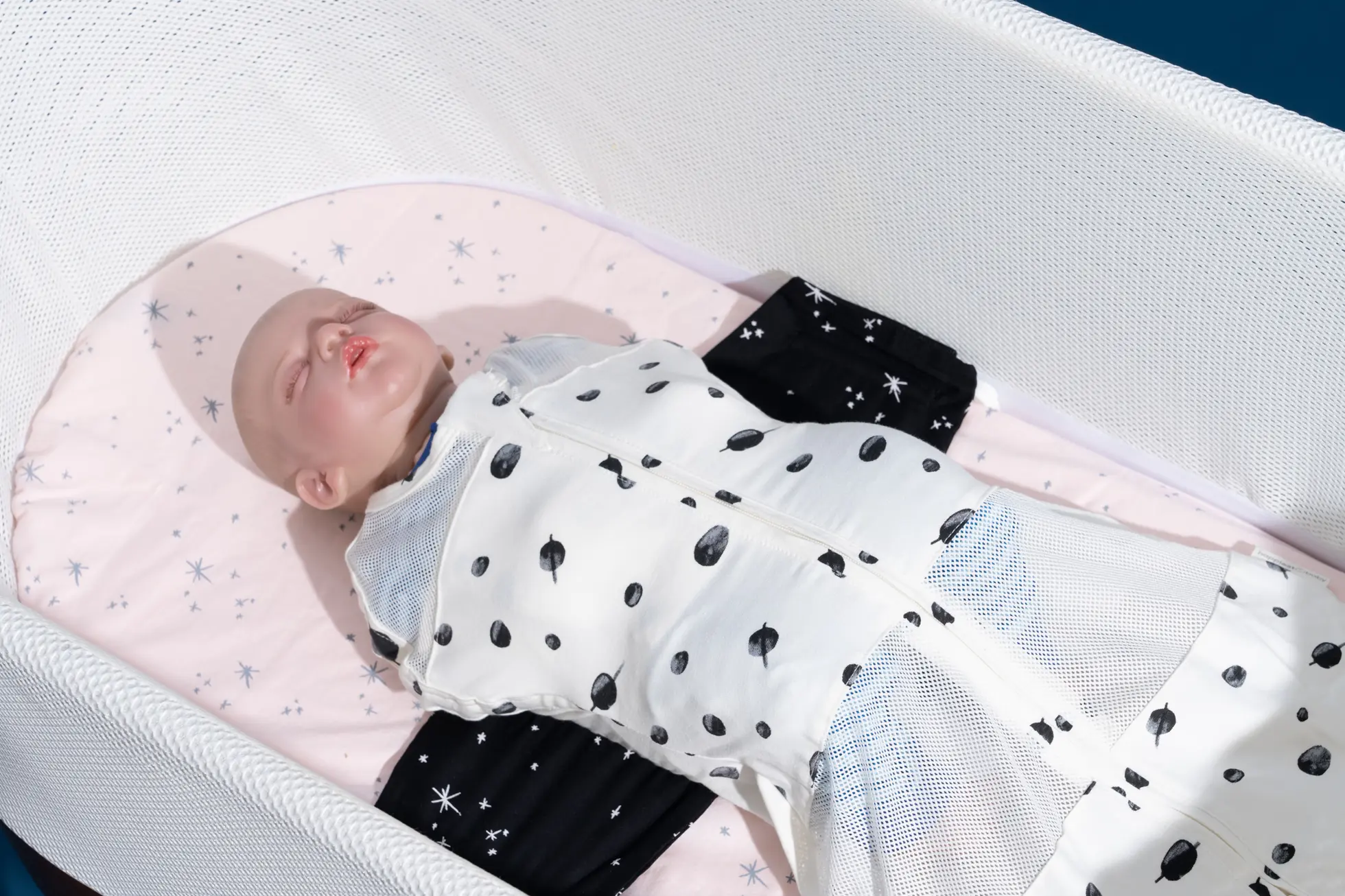
The Snoo Smart Sleeper builds upon pediatrician Dr. Harvey Karp’s renowned “5 S’s” soothing framework—swaying, shushing, and swaddling among them—originally detailed in his 2002 book The Happiest Baby on the Block. While caregivers traditionally performed these calming techniques manually, the Snoo mechanizes the process, replicating the rhythmic movements and auditory patterns of the womb to prolong infant sleep with minimal parental effort.
Visually, the bassinet blends functionality with minimalist design: white mesh panels encircle the sleep area, supported by a polished wooden frame and metallic legs that evoke modern Scandinavian aesthetics. Its water-resistant mattress cover and washable mesh surfaces simplify maintenance, though the 38-pound weight limits portability. Setup requires no tools, and the included Snoo Sleep Sacks—proprietary swaddles with secure clips—ensure safe positioning by immobilizing infants on their backs. Notably, the bassinet’s motion features activate only when these swaddles are properly attached.
The companion app offers tiered functionality. A free basic version allows manual control of motion speeds and sound levels, plus baby activity alerts. A premium subscription (included for 9 months with new purchases) adds sleep/feeding tracking and advanced customization. Post-July 2024 buyers receive this upgrade automatically, while secondhand owners or extended users pay $20 monthly. Rentals include premium access for the rental period plus one bonus month.
By digitizing time-tested parenting techniques, the Snoo bridges biological comfort with technological innovation—though its effectiveness ultimately depends on how infants respond to automated soothing versus human touch.
Key Considerations
The Snoo’s steep price tag—159/month offers a short-term alternative. Additional costs include extra Sleep Sacks (35 each), required for safe operation as babies grow.
While praised by some, the Snoo doesn’t guarantee success. Some infants reject its automated soothing, and transitioning to a crib post-4–6 months can prove challenging. Experts caution that its effectiveness in prolonging sleep might lead parents to overlook essential feedings, risking underfeeding. Lactation consultant Aleesha Burke warns that prolonged sleep intervals without scheduled feeds could contribute to “failure to thrive” in vulnerable infants.
Physical therapists Stacy Conder and Susan Klemm raise developmental concerns: restricted movement in the Snoo’s swaddle may worsen positional conditions like flat head syndrome (plagiocephaly) and neck muscle tightness (torticollis). Extended use up to six months could also delay motor milestones like rolling, as the swaddle immobilizes infants. Notably, the bassinet lacks storage, a practical downside for nighttime essentials.
Technical Specifications
- Assembly time: 3 minutes
- Dimensions: 35.75” L x 19” W x 31” H
- Weight: 38 pounds
- Weight limit: 25 pounds
- Adjustability: None
- Storage: None
- Included: 3 Sleep Sacks (purchase) or 2 (rental), 1 fitted sheet
- Features: Responsive motion, white noise
For detailed testing insights, explore Is the $1,700 Snoo Smart Sleeper Bassinet Worth It? What to Know Before You Buy.
